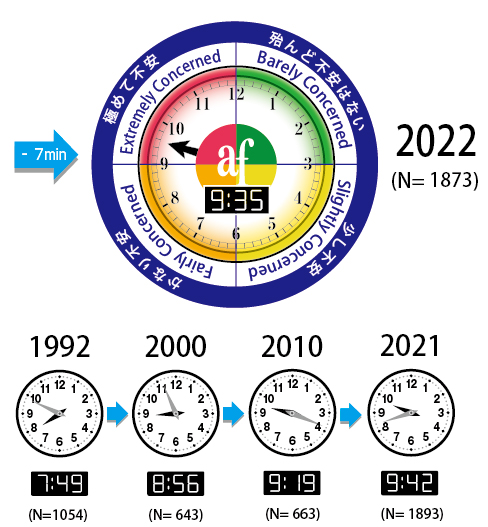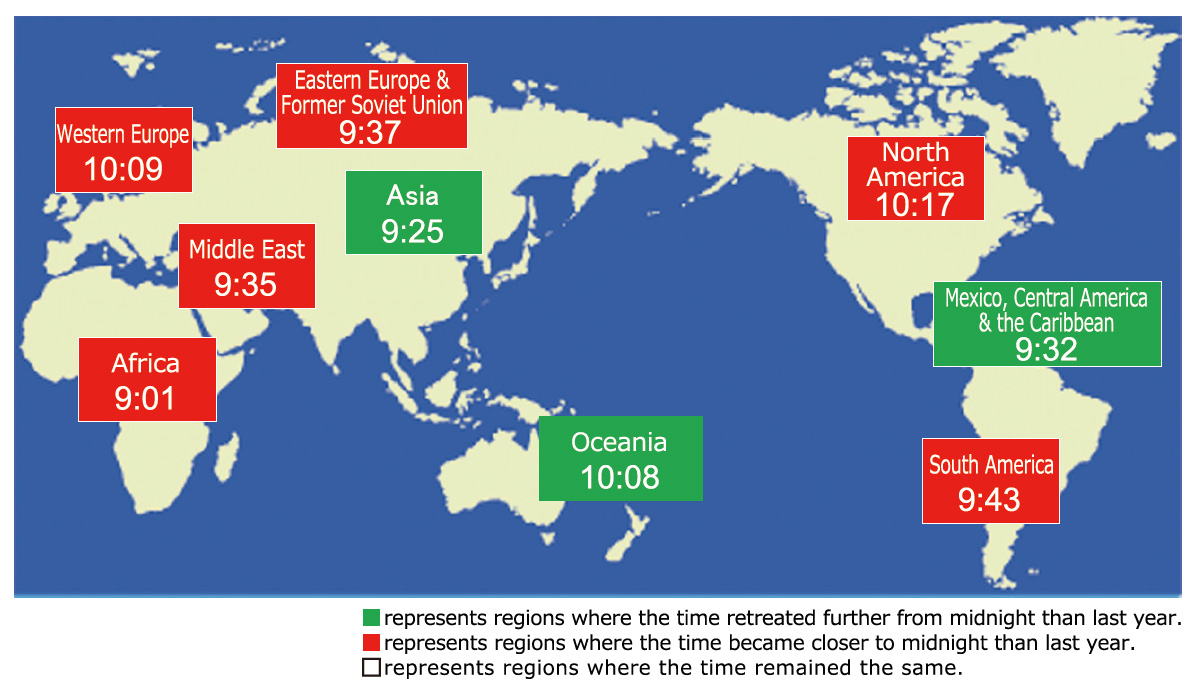
The Asahi Glass Foundation Announces the Results of the 31st Annual “Questionnaire on Environmental Problems and the Survival of Humankind”
2022.09.08
Further details are available in the report of the “31st Annual Questionnaire on Environmental Problems and the Survival of Humankind,” or online at the Foundation’s web site, starting at 11 a.m. September 8.
Summary
● The time on the Clock has turned back for two consecutive years since 2021, striking 9:35 in 2022. It was the first period in 12 years the time on the Clock had gone back for two consecutive years.
● Looking at the times on the Clock around the world, the time moved forward more than 10 minutes in North America, Africa, Middle East, and Eastern Europe & former Soviet Union.
● "Climate Change" has been the top environmental issue since 2011 that the respondents worldwide have had on their minds.
● The advances made in “Policies and Legal System” and “Social Infrastructure (Funds, Human Resources, Technologies, and Facilities)” were less pronounced than those for “Public Awareness.”
● The category most commonly identified as showing signs of improvement in approach was “Climate Change” (30.0%), followed by “Society Economy and Environment, Policies, Measures” (15.1%), and “Lifestyle (Consumption Habits)” (14.5%).
● In respondents’ worldview, “l. No Poverty” was the most selected as the goal that will have the lowest level of realization in 2030, followed by “2. Zero Hunger,” and “16. Peace, Justice and Strong Institutions.”
I. Level of the Crisis Facing Human Survival - The Environmental Doomsday Clock
I-1 The Time on the Environmental Doomsday Clock
・Looking at the time on the Clock around the world, the Clock went back more than 10 minutes compared to last year in Asia and Oceania, regions which face the Pacific Ocean, but it moved forward more than 10 minutes in North America, Africa, Middle East, and Eastern Europe & former Soviet Union, showing a bipolarized tendency.
・The time on the Clock for the world had been moving forward since 2011. However, it has turned back for two consecutive years since 2021, striking 9:35 in 2022. It was the first period in 12 years the time on the Clock had gone back for two consecutive years.
I-2 Change in the Time on the Environmental Doomsday Clock by Generation (2013 - 2022)
・This year, the only respondents who reported advanced times on the Clock were those in their 60s and over, but the Clock was set back among respondents in their 20s to 50s.
・Since 2013, when the Clock was 9:01, the times reported by respondents in their 20s and 30s had mostly kept moving forward, but in 2018, the time on the Clock hit 10:00 for these age groups due to the impact of the growing sense of crisis among the Chinese respondents in their 20s and 30s. The time reported this year was as much as 16 minutes earlier than the previous year.
・There are many survey respondents in China and those in their 20s and 30s, who account for nearly 90% of the total number of respondents in China, seem to consider that environmental issues in China have improved due to the environmental measures being taken by the Chinese government.
II. “Environmental Issues to be Taken into Account” in Determining the Time on the Clock In determining the time on the Environmental Doomsday Clock, the questionnaire asked respondents to select, from the following nine categories of environmental problems, the three most pressing issues for the country or region where they reside, and rank them in order of importance. (See the Questionnaire Report for further details.)
Nine Environmental Issues to be Taken into Account:
1. Climate Change, 2. Biosphere Integrity (Biodiversity), 3. Land-system Change (Land Use), 4. Biochemical Flows (Pollution/Contamination), 5. Water Resources, 6. Population, 7. Food, 8. Lifestyle (Consumption Habits), 9. Society, Economy and Environment, Policies, Measures
II-1 Weighted Average Selection Percentage of the Nine Environmental Issues
・The top two issues that the respondents selected in determining the time on the Environmental Doomsday Clock have remained unchanged for four years in a row: “Climate Change” ranked first (32%), followed by “Biosphere Integrity (Biodiversity)” at 13%. The percentage of each issue has changed little for five years.
II-2 Weighted Average Time on the Environmental Doomsday Clock of the Nine Environmental Issues
・When arranging the “environmental issues to be taken into account” for the entire world on the Environmental Doomsday Clock, “Society, Economy and Environment, Policies, Measures” was at 9:49, “Biosphere Integrity (Biodiversity)” 9:43, “Climate Change” 9:40, and “Lifestyle (Consumption Habits)” 9:38, were all closer to midnight than the world’s average time of 9:35.
・It is noteworthy that although “Biosphere Integrity (Biodiversity)” had shown the closest time to midnight until last year, “Society, Economy and Environment, Policies, Measures” became the issue with the strongest sense of crisis and the Clock moved forward by 15 minutes from 9:34 last year to 9:49 this year. It seems that Russia’s invasion of Ukraine has affected this result.
III. Signs of Improvement in the Approach to Environmental Issues: Comparison with the Situation Prior to 2015, When the Paris Agreement and SDGs Were Adopted Signs of improvement were investigated from the three perspectives, (1) Public Awareness, (2) Policies and Legal System, and (3) Social Infrastructure (Funds, Human Resources, Technologies, and Facilities). We asked, from a list of “Environmental Issues to be Taken into Account,” the respondent’s opinion on whether there have been signs of improvement in the approach to global environmental issues with respect to a decarbonized society and where they saw signs of improvement.
We calculated the average score by quantifying the answers on whether there had been any improvements and giving a score of “-2” for the answer “Definitely not,” “-1” for the answer “Not really,” “0” for the answer “Cannot say either way,” “+1” for the answer “Somewhat,” and “+2” for the answer “Definitely.”
III-1 Progress in a Transition to a Decarbonized Society
・Overall, with regard to transitioning to a decarbonized society, the results showed an equal lack of progress in “Policies and Legal System” and “Social Infrastructure (Funds, Human Resources, Technologies, and Facilities)” compared with “Public Awareness.”
III-2 Categories Showing Signs of Improvement
・The category most frequently selected for showing signs of improvement was “Climate Change” at 30.0%, followed by “Society, Economy and Environment, Policies, Measures” at 15.1%, and “Lifestyle (Consumption Habits)” at 14.5%.
・Concerning efforts against “Climate Change,” the respondents see more improvements in “Public Awareness (1.28)” than in “Policies and Legal System (0.75)” and “Social Infrastructure (0.71).” The score of each issue has changed little since last year.
IV Realization of 17 sustainable development goals (SDGs) in 2030 Regarding realization of 17 sustainable development goals (SDGs) in 2030, we asked the respondents to choose and rank three goals (out of 17 SDGs) that will have the highest/lowest level of realization in 2030, in terms of the realization level in respondents’ world view and in the respondents’ own country/region. Responses were analyzed by the 1st-3rd summation method. More detailed data is available in the 2022 annual report of the survey.
・In respondents’ world view, “9. Industry, Innovation, and Infrastructure” and “13. Climate Action” were selected by respondents in many countries as the top two goals that will have the highest level of realization in 2030, followed by “7. Affordable and Clean Energy.”
・“1. No Poverty” was selected as a goal that will have the lowest level of realization in 2030, followed by “2. Zero Hunger,” and “16. Peace, Justice and Strong Institutions.” This is an indication that many people around the world believe these goals are difficult to achieve.
・In many countries and regions, “2. Zero Hunger,” “4. Quality Education,” and “6. Clean Water and Sanitation” were selected, on average, as goals that will have the highest level of realization in 2030.
・In the respondents’ own country or region, “1. No Poverty,” “10. Reduced Inequalities” and “13. Climate Action” were most commonly selected as goals that will have the lowest level of realization in 2030. The first two goals were also most commonly considered to have the lowest level of realization on average, indicating that these are common major challenges worldwide.
This survey includes a section where respondents are invited to provide their opinions and write about the environmental realities they face in their region of the world, as well as offer suggestions for improvement. This year, we received a total of over 700 comments from 95 countries abroad. These comments will be published on the Asahi Glass Foundation website at 11a.m. on September 8.
● Facts about This Year’s Questionnaire
Survey period: April to June 2022
Respondents:
Environmental experts who work or who have worked for national or local governments, NGOs, NPOs, universities, research institutions, corporations, and mass media, worldwide (listed on the Asahi Glass Foundation database).
Number of questionnaires mailed:25,770
(23,997 to overseas respondents and 1,773 to respondents in Japan)
Number of questionnaires returned: 1,876
Response rate: 7.3%
[Contact]
Toshihiro Tanuma, PhD, Director, Commendation, “Blue Planet Prize”
The Asahi Glass Foundation
2nd Floor, Science Plaza 5-3 Yonbancho Chiyoda-ku Tokyo 102-0081, Japan
Phone: +81-3-5275-0620 Fax: +81-3-5275-0871 e-mail: post@af-info.or.jp URL: https://www.af-info.or.jp
----------------------------------------------------------------------------------------
Photos (From the left):
① The Time on the Environmental Doomsday Clock
② Regional Times on the Environmental Doomsday Clock




